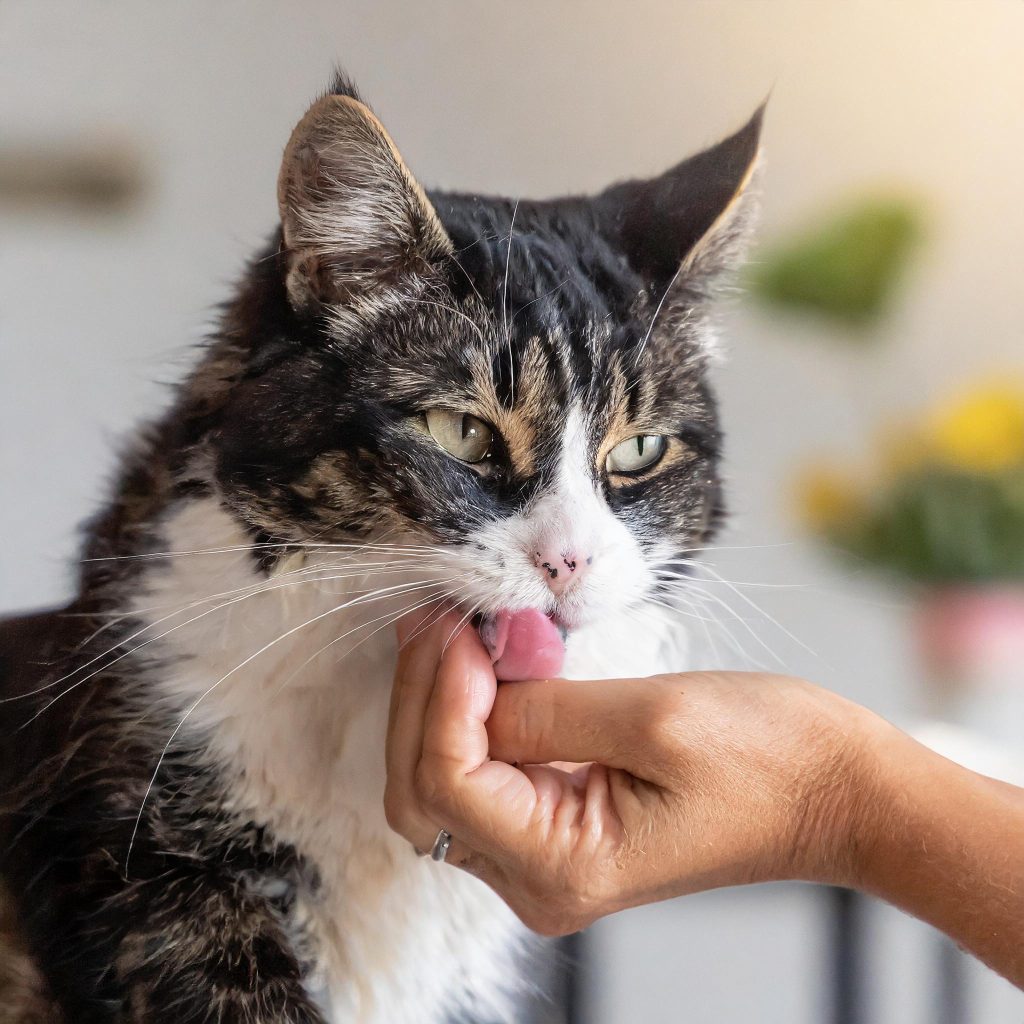If you’re a cat parent, you’ve probably been on the receiving end of a sandpapery tongue bath or those little “love bites” that often come out of nowhere. Feline licking and biting behaviors can be equal parts endearing and confusing, so let’s look at decoding what your kitty is really trying to tell you.

The Licking Lowdown
When your cat licks you, it’s generally a good sign that they feel comfortable around you and see you as a bonded member of their family. Cats lick to groom themselves, but also each other, especially in those hard-to-reach spots their little contortionist bodies can’t quite manage alone. So if your cat is giving you a licking, it likely means they’re showing you affection in their own special way.
However, obsessive licking can sometimes indicate an underlying issue like anxiety, stress, or a medical condition like excessive grooming disorder. If the licking seems over-the-top, it’s a good idea to call your vet to rule out any health problems. You may also need to consult an animal behaviorist to curb the licking back to normal “let’s play and cuddle” levels.
Licking can also be your cat’s way of getting your attention because they want to play, snuggle, or score some primo petting. After all, we know cats are masters at training humans to cater to their whims.
The Bite Buzz
Now let’s talk about those little love bites or nips you sometimes get while petting or playing with your cat. Don’t be alarmed — biting is just another way for cats to communicate with you.
For starters, cats bite to say “that’s enough” when they’ve had enough petting or grooming in a certain area. Those highly tuned feline senses can become overstimulated by too much touching, causing them to nibble as a signal for you to move along.
Cats may also bite themselves during a licking session because their rough tongue alone isn’t always enough to get a stubborn knot or ball of fur untangled from their luxurious coat.
Additionally, biting can be an accidental habit passed down from kittenhood. When cats are young, they learn to stalk, hunt, and bite while playing. If you encouraged this rough behavior by using your hands and feet as play toys when they were kittens, you’ve effectively trained your feline friend that those body parts are fair game for nibbling as adults. So those little bites are just your cat’s way of treating you like a littermate.
Paw-sitively Delicious
In some cases, a cat may lick or nibble you simply because you taste or smell appetizing to their keen senses. The salt on your skin could be tempting that sandpapery tongue. Or perhaps you had a food spill or crumb you didn’t notice that’s driving your cat’s sudden oral fixation.
Cats are incredibly curious by nature, able to sniff out the faintest traces of interesting scents and flavors. So if a splatter or stuck-on morsel is the purr-pose of their snack attack, it won’t be long until you’re back to your usual, not-so-tasty self.
Mouthy Cat-titude
In addition to communicating, a cat’s licking and biting can sometimes reflect their individual personality or attitude. Some cats are simply orally fixated more than others. Like human quirks, this could just be your particular kitty’s way of engaging with the world and the people they love.
On the flip side, licking and biting can occasionally signal possessiveness, especially in multi-cat households. If your cat seems to lick or nip at you more when other pets are around, they may be establishing you as their personal property — a territorial, “hands off my human” kind of statement.
Lastly, don’t underestimate the power of reinforcement. If you giggle, pet, or give attention to your cat when they lick or deliver a little love bite, you’re unintentionally rewarding and encouraging that behavior, a sure-fire way to repeat the performance.
The Purr-fect Approach
Learning your cat’s licking and biting cues is key to being a responsible and understanding pet parent. While these behaviors may sometimes be inconvenient, they’re usually well-intentioned expressions of your cat’s need for bonding, play, grooming, and personal space.
With some observation and by patiently setting boundaries, you can reduce excessive licking and redirect biting habits in a positive way through reward-based training. Just remember that licking and nibbling aren’t necessarily “bad” cat behaviors — they’re your furry friend’s way of chatting with you in their own charming language.
